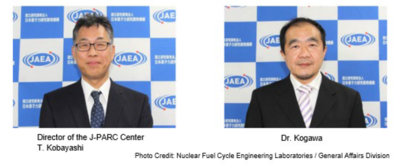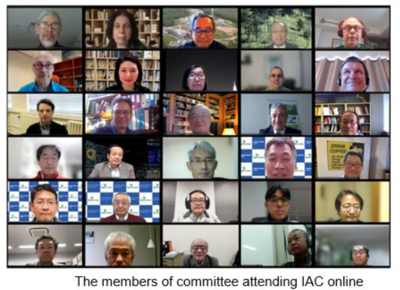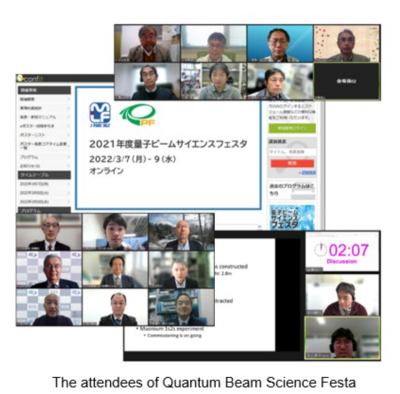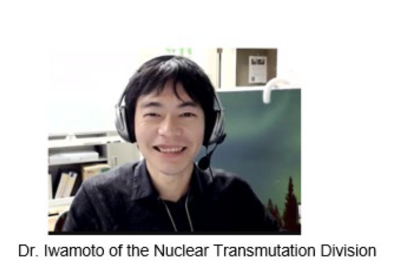J-PARC News March 2022 (Issue #203)
■Successful Nondestructive Quantitative 2D Analysis of Deterioration in Charging Capacity of Lithium-ion Rechargeable Battery - Detection and quantification of deterioration promotion sites affecting life of batteries for each crystal phase of anode material -(February 3)
Lithium-ion batteries, used in electric cars and electronic devices, are all excellent products but have one major issue: deterioration over time because of repeated charge-discharge cycles. When charging, lithium ions move from the cathode to anode and slide between layers of anode material, such as graphite. The key to finding the cause of capacity deterioration is to uncover details like the type and density of crystals that hold lithium ions without taking them out of the cell.
The team led by Chief Researcher Koichi Kino of the National Institute of Advanced Industrial Science and Technology conducted Bragg-edge imaging of new and deteriorated lithium-ion batteries for commercial smartphones using SPICA, J-PARC’s special environment neutron diffractometer. In neutron transmission spectra, the wavelength where the transmittance suddenly changes are called “edges,” and their wavelength corresponds to the difference in the crystal structure (e.g., Li1C6, Li0.5C6, Li0.04C6) and their height reflects the density of the crystals. The team performed two-dimensional analysis of neutron transmission spectra, and derived the density distribution of lithium ions in the crystal structures inside charged batteries. As a result, it was found that crystals with less lithium-ion density were locally distributed in a deteriorated battery, indicating that battery deterioration progresses nonuniformly. Future studies will include operando observation of discharging batteries taking advantage of high-intensity beams of J-PARC, which is expected to lead to extended battery life.
For details, please refer to the following article.
https://j-parc.jp/c/press-release/2022/02/03000807.html
*** You can watch the video about the detail on YouTube but only in Japanese without other languages’ captions. ***
■Predicting and Controlling Flowability of Hydrogel by DNA - Potential medical applications such as cell culture media and injectable gel drugs-(February 17)
Hydrogels are soft and fluid materials, typically found as yogurt and slime in our daily life. They are also used as medical materials, including artificial vitreous body and antiadhesives. When applying hydrogels to medical materials, it is important to predict and control their flowability. Hydrogels are formed by three-dimensionally cross-linking polymers, and their flowability can be controlled by adjusting the stability of the crosslinking. However, it has been difficult to control the stability as intended under physiological conditions to date.
Considering the fact that the base sequence of a DNA greatly affects the stability of the DNA’s double-stranded structure, Associate Professor Xiang Li at Hokkaido University and co-workers thought they would be able to freely control the flowability of hydrogel if they made a new hydrogel cross-linked by DNA double strands. In this study, the team found a clear correlation between the stability of a double-stranded structure and the flowability of gel. They also discovered by small-angle neutron scattering measurement using TAIKAN at J-PARC that the positions of scattering peaks are unchanged even when the flowability was changed from a gel state to a sol state by increasing the temperature, indicating that the DNA strands retain the same distance and an orderly network structure was formed. This finding suggests possible applications of hydrogels in the field of medicine as, for example, cell culture media and injectable gel materials that have organism-like flowability.
For details, please refer to the following article.
https://j-parc.jp/c/press-release/2022/02/17000833.html
*** You can watch the video about the detail on YouTube but only in Japanese without other languages’ captions. ***
■16th Tokai Forum: From Tokai Region to the Future – Frontline Research and Decommissioning Technology – (February 28, video release)
The Tokai Forum is a conference to report on the latest results of research conducted at the Nuclear Fuel Cycle Engineering Laboratories, Nuclear Science Research Institute, and J-PARC Center to facilitate better understanding of activities of Japan Atomic Energy Agency (JAEA). Subsequent to the last year, recorded videos were released this year.
First, Executive Director Hiroyuki Oigawa of JAEA made a greeting address and outlined JAEA’s laboratories. From J-PARC, Director Takashi Kobayashi described the structure and characteristics of three accelerators at J-PARC, and talked about research results of the Materials and Life Science Experimental Facility (MLF), including improved performance of lithium-ion rechargeable batteries, nondestructive analysis of Ogata Koan's sealed medicine and samples of asteroid Ryugu returned by Hayabusa 2, commencement of research for sterile neutrinos, experiment to create a state similar to a neutron star, and advancement of T2K experiment for neutrinos. Then, Assistant Principal Researcher Hiroyuki Kogawa of the Neutron Source Section gave a presentation titled “Development of Damage Suppression Technology on the Mercury Target Vessel at J-PARC,” detailing the development process of a mercury target that stably supplies neutrons with the world’s highest intensity, where damage of the vessel that is caused by impact pressure generated in mercury due to incidental proton beams is suppressed by injecting cushioning microbubbles into the mercury.
Please watch them on the website of Nuclear Fuel Cycle Engineering Laboratories
https://www.jaea.go.jp/04/ztokai/forum/
*** You can watch the video about the detail on YouTube but only in Japanese without other languages’ captions. ***
■The International Advisory Committee (IAC), Holds International Advisory Committee Meetings (from February 2 to March 4)
A series of international advisory committee meetings was held in which J-PARC received advice on its activities and future plans from experts inside and outside Japan. Meetings of the four committees for Transmutation Experimental Facility (TEF) Technical Advisory Committee (T-TAC), Muon Advisory Committee (MAC), Neutron Advisory Committee (NAC), and Accelerator Technical Advisory Committee (A-TAC) were held from February 2 to 21,2022, and the International Advisory Council (IAC) meeting including reports from these four meetings was held on March 3 and 4,2022. At the IAC meeting, J-PARC made a report
on its overall response to the advice received at the previous meetings, and the committee members gave high praise and new advice on J-PARC’s wide-ranging activities. From this year, two committee members in the disciplines of humanities and social sciences joined the IAC meeting, and they recognized that J-PARC’s public relations activities and communications were at very high levels and greatly helping in improving people’s awareness of its social contributions.
■ Quantum Beam Science Festa FY2021 Held (from March 7 to March 9) 13th MLF Symposium, 39th PF* Symposium
QBSF is held every year by KEK Institute of Materials Structure Science, J-PARC Center, Comprehensive Research Organization for Science and Society, PF User Association, and J-PARC MLF Users Society. A total of 522 persons, most of whom were MLF and PF users, participated in the QBSF and Symposium online this year. At the MLF Symposium, reports were made on the new experimental area S2 for muons, introduction of machine learning, remotization and automation of MLF experiment equipment, and complementary use with JRR-3. Also, the MLF Users Society summarized requests for MLF based on the results of questionnaire surveys, and opinions were exchanged about MLF’s situation and response policy toward them. QBSF started with two keynote lectures on molecular geochemistry using synchrotron radiation and unique martensitic transformation of Heusler-type shape memory alloy. After that, parallel sessions under the keywords of operando, materials, life, basic physics, and physical properties were held, followed by about 250 poster presentations including reports of achievement in the advancement of quantum beam line. In addition, at the PF Symposium, talks were made on the advancement of beam lines, future plans, and other key topics.
* KEK Photon Factory
■J-PARC Hello Science “High Energy Nuclear Reaction Probed by Proton Beams” (February 25)
The lecturer was Dr. Hiroki Iwamoto of the Nuclear Transmutation Division, and 22 persons attended online.
J-PARC conducts various research and development using secondary particles generated by spallation reaction of high energy protons and nuclei, and nuclear transmutation research to reduce nuclear waste is one of them. In spallation reactions, not only neutrons that play an important role in nuclear transmutation of radioactive waste but also difficult-to-handle spallation products are generated. To progress nuclear transmutation research, it is important to accurately predict spallation products as well as neutrons.
At the lecture, Dr. Iwamoto explained how spallation reaction occurs when a proton beam is irradiated onto a material, and outlined the experiment carried out using J-PARC’s proton beams to measure neutrons and spallation products. In addition, he talked about research to improve the prediction accuracy by adopting new data sciences and AI technologies such as machine learning.
■Information
(1) 2nd J-PARC online lecture (March 25, 13:30-15:00, livestreamed on YouTube)
“Myriads of Materials in the Universe Created by Quarks as Elementary Particles – J-PARC’s Challenge to Elucidate Them –” was streamed on YouTube.
For details, please refer to the following article.
http://www.j-parc.jp/c/information/2022/02/28000836.html
*** This event ended successfully. You can still watch this lecture on YouTube but only in Japanese without other languages’ captions. ***
(2)National Museum of Nature and Science special exhibition archive video clips published
Archive video clips of the special exhibition “Particle Accelerators: Exploring the Tiny World with Huge Machines” held at the National Museum of Nature and Science from July to October 2021 were published.
Please watch them at the YouTube Kahaku Channel.
https://www.youtube.com/playlist?list=PL38SvBUmO1PdX03EMyU2PstodT263832U
*** This event ended successfully. You can still watch this lecture on YouTube but only in Japanese without other languages’ captions. ***
(3)J-PARC Hello Science livestreamed (April 22, 18:00-19:00)
This April’s Hello Science “Delving into the Mysteries of the Universe and Materials with High Intensity Proton Acceleration Facilities J-PARC” (Lecturer: Takashi Kobayashi, Director of J-PARC Center) was streamed on the YouTube KEK Channel as part of the science and technology week promoted by the Japanese government. Please watch our lively video at the YouTube KEK channel.
*** This event ended successfully. You can still watch this lecture on YouTube but only in Japanese without other languages’ captions. ***
■Sanpo-michi #21: Acorns Taking Roots
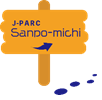
This year’s winter was frigid, and the first storm of spring arrived one month later than last year. However, the temperature then suddenly rose, and we have since been battered by gales. Today, I can see from the J-PARC Research Building that the Pacific Ocean is covered with a blanket of white waves, clouds are tearing about, and the smoke coming out of the neighboring coal-fired thermal power plant is streaming sideways. Branches of trees in the forest right beneath the Research Building are rustling, and ripples can be seen on the small pond that birds visit to have a drink. Did you know, though, things are quietly happening on the floor of the forest? At this time of the year, acorns of konara oaks, which are spread throughout this forest, are holding fast against strong winds, patiently waiting for the time to send out arms and roots.
Late autumn is the season of Donguri Korokoro*. In that season, pericarps of acorns are rich in moisture and oil, making them hard and elastic. Even when there is no wind, acorns fall to the ground with a gentle sound and roll down afar on the slightest of slopes. But that is not all. It is said that their spindle shape and the cupule they wear are their strategy to randomize their traveling direction and make their habitat as widespread as possible. Come winter, pericarps become dry and less elastic, and acorns settle in wherever they happened to be. After the first storm of spring, acorns who luckily settled in a sunny place crack open their now brittle pericarps and expose the seed coat. When the yellow-green seed coat turns red, roots start to emerge and the root tip sinks underground.
While clouds of cedar pollen fill the air, as the Vernal Equinox Day draws near, the sun shines brightly and trees cast clear shadows on the ground. Pale pink buds start to blossom on tree branches. March, the month acorns take root. This is the brightest season of the year.
* Donguri Korokoro (Acorn Rolling Down): popular Japanese children’s song.



